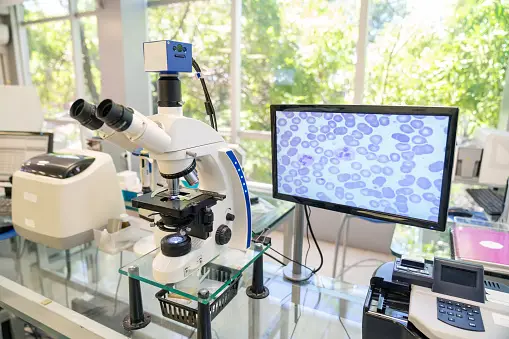Dive into the captivating world of forensic science evolution and its impact on solving crimes. This article highlights the progression from traditional methods to modern, innovative techniques that shape today’s investigations. Discover how forensic science has revolutionized our approach to unraveling mysteries, showcasing both its successes and the technological advancements that drive it forward. Each step in this journey reveals the dynamic relationship between crime-solving and evolving technology.
What Is Forensic Science?
Forensic science, a captivating intersection of scientific inquiry and criminal investigation, is the meticulous investigator of truth in complex and multifaceted legal proceedings. Forensic science employs diverse scientific techniques and technologies to scrutinize physical evidence, offering a systematic and comprehensive approach to unraveling mysteries, solving crimes, and bringing justice to the forefront of legal discourse.

Pillars Of Forensic Science
DNA analysis, a revolutionary progress in forensic science, has become synonymous with criminal investigations. By scrutinizing the unique genetic code in every person’s DNA, forensic experts can establish links between suspects and crime scenes or victims, significantly enhancing the accuracy of identifications and identifying potential suspects. The Human Genome Project and advancements in DNA sequencing technologies have further expanded the capabilities of forensic DNA analysis, allowing for more intricate profiling and differentiation.
Forensic toxicology, another vital branch, navigates the intricate landscape of poisons and drugs. Through careful examination of bodily fluids, tissues, and hair, toxicologists can identify the presence of substances, shedding light on potential motives or circumstances surrounding a crime. This extends beyond homicides to cases involving substance abuse, driving under the influence, or accidental poisonings.
The field of forensic pathology steps into the macabre, where forensic pathologists meticulously dissect and analyze cadavers to determine the cause and manner of death. Their expertise is crucial in untangling the circumstances leading to fatalities, be it natural, accidental, homicidal, or suicidal. The autopsy table becomes a canvas for unraveling the narratives of lives lost and crimes committed, and advancements in post-mortem imaging techniques provide additional tools for forensic pathologists to explore.
Fingerprint analysis, an age-old yet continuously changing discipline, remains a cornerstone of forensic investigations. The unique ridges and patterns on the fingertips offer an unparalleled method of identification. Advanced technologies, such as Automated Fingerprint Identification Systems (AFIS), have transformed fingerprint analysis, enabling quicker and more accurate matches.

Forensic odontology often ignored but equally compelling, employs the unique features of dental structures to identify individuals. Bite marks, dental impressions, and comparisons with dental records play a crucial role, especially when traditional identification methods are challenging. The collaboration between forensic odontologists and other forensic specialists underscores the interdisciplinary nature of forensic science.
Forensic Science and Tech
The utilization of cutting-edge technologies, such as digital forensics, has propelled forensic science into the digital age. Analyzing electronic devices, computer systems, and networks, digital forensic experts uncover a wealth of information, from incriminating communications to traces of cybercrime. As our world becomes increasingly interconnected, the role of digital forensics continues to expand, encompassing not only traditional crimes but also those committed on the internet.
Forensic experts don the hat of expert witnesses in courtrooms, presenting their findings and interpretations to judges and juries. The weight of their testimony can tip the scales of justice, making the distinction between guilt and innocence. The ability to convey complex scientific concepts in a comprehensible manner becomes paramount, ensuring that the triers of fact can grasp the significance of forensic evidence. The importance of effective communication skills for forensic experts cannot be overstated, as they bridge the gap between the technical intricacies of their analyses and the understanding of a diverse audience in the legal system.
While the strides in forensic science have undoubtedly enhanced the investigative toolkit, challenges persist. Controversies surrounding the reliability of certain forensic techniques, the need for standardized practices, and the demand for ongoing education to keep pace with technological advancements all underscore the evolving nature of this field. The advent of forensic science reform movements aimed at addressing these challenges and ensuring the reliability and validity of forensic evidence emphasizes the commitment to the continuous improvement of forensic practices.

What Constitutes Evidence In Court?
Understanding what constitutes evidence in court is pivotal for navigating the intricate web of legal proceedings. Evidence, in its various forms, emerges as the foundation for legal arguments and decisions.
Types of Evidence:
1. Real Evidence: Tangible items presented in court, ranging from murder weapons to documents, fall under this category. The physical presence of real evidence adds a palpable dimension to legal proceedings, anchoring arguments in the material world.
2. Demonstrative Evidence: Visual aids, such as charts, graphs, and multimedia presentations, come into play as demonstrative evidence. These tools serve to clarify complex issues, offering a visual narrative that complements verbal arguments.
3. Documentary Evidence: Written or recorded materials, including contracts, emails, and photographs, constitute documentary evidence. This category encompasses diverse sources that contribute to building a factual foundation for legal arguments.
4. Testimonial Evidence: Uttered words carry weight in the courtroom, and testimonial evidence relies on the statements of witnesses. Witness testimonies provide a firsthand account of events, serving as a dynamic element in the quest for truth.
Admissibility Criteria:
The admissibility of evidence hinges on several key criteria designed to ensure fairness and reliability in legal proceedings. Courts employ stringent standards to evaluate the evidence’s relevance, authenticity, and credibility. Understanding these criteria is essential for legal practitioners and those seeking justice:
1. Relevance: Evidence must be directly related to the issues at hand to be deemed admissible. Irrelevant information can cloud the proceedings and divert attention from the core matters of the case.
2. Authenticity: Establishing the origin and authenticity of evidence is important. Courts require a clear chain of custody to ensure that the presented materials are genuine and have not been tampered with.
3. Reliability: The reliability of evidence is crucial for its acceptance in court. Scientific evidence, for instance, must meet specific reliability standards to be considered valid.
4. Hearsay Rule: Courts generally exclude hearsay evidence, which is an out-of-court statement offered to prove the truth of the matter asserted. Exceptions exist, but the rule underscores the importance of firsthand, reliable information.
Digital Evidence in the Modern Age:

As technology advances, the landscape of evidence in court undergoes a transformative shift. Digital evidence, encompassing emails, social media posts, and electronic records, introduces its own set of challenges and opportunities. Ensuring the admissibility of digital evidence requires understanding technological nuances and a recognition of its role in contemporary legal disputes.
The Evolution of Forensic Science and Its Impact on Evidence Exhibits
- The Historical Roots of Forensic Science:
The historical roots of forensic science delve deep into the chronicles of human civilization. Early attempts at identifying individuals and solving crimes included the Babylonian use of fingerprints on clay tablets for business transactions. However, in the 19th century, figures like Sir Francis Galton laid the groundwork for systematic approaches to evidence collection and analysis.
- The Revolution of DNA Analysis:
A watershed moment in the evolution of forensic science occurred with the discovery of the double helix structure of DNA. James Watson and Francis Crick did this in the 1950s. This groundbreaking revelation paved the way for the development of DNA profiling. This revolutionary tool enhanced the accuracy of identifying individuals. It also provided investigators with a means to link suspects to crime scenes with remarkable precision.
- Advancements in Trace Evidence Analysis:
Forensic science continued to advance with the meticulous examination of trace evidence. Microscopic analysis of hair, fibers, and other minute particles became standard practice, offering investigators valuable insights into a crime’s circumstances. The careful scrutiny allows for a more comprehensive understanding of the intricacies of criminal investigations.
- Digital Forensics in the Digital Age:

The transition into the digital age brought forth a new frontier for forensic science. Digital forensics, encompassing the examination of electronic devices and data, became an integral aspect of modern investigations. The analysis of digital evidence, including emails, social media interactions, and electronic documents, added layers of complexity to evidence exhibits. It also reflects the evolving nature of criminal activity in our technologically driven society.
- Challenges and Ethical Considerations in Forensic Science:
Forensic science embraced sophisticated technologies and encountered challenges and ethical considerations. Questions surrounding the reliability and admissibility of certain forensic methods, such as bite mark analysis and hair comparison, prompted a critical reevaluation of established practices.
The Future Horizon of Forensic Science:
Looking forward, the future of forensic science holds promises of even greater precision and innovation. Advances in areas like facial recognition technology, artificial intelligence, and forensic anthropology continue to shape the field. These ongoing developments enhance the capabilities of investigators and contribute to the creation of more technologically advanced evidence exhibits.
Conclusion
In conclusion, the forensic science evolution stands as a powerful testament to our unending quest for justice. Starting with ancient fingerprinting techniques and advancing to today’s sophisticated technologies, forensic science has dramatically transformed evidence analysis. This journey not only highlights the intricate relationship between science and law but also underscores the ongoing commitment to pushing the boundaries of truth and justice. As we explore this captivating saga, forensic science continues to play a crucial role in shaping our legal landscape.
How has fingerprint analysis evolved over time?
Fingerprint analysis, an age-old discipline, remains a cornerstone of forensic investigations. Advanced technologies, such as Automated Fingerprint Identification Systems (AFIS), have transformed fingerprint analysis, enabling quicker and more accurate matches. Ongoing exploration of friction ridge skin variation continues to enhance precision and reliability.
What is the significance of digital forensics in the modern age?
Digital forensics analyzes electronic devices, computer systems, and networks, uncovering a wealth of information from incriminating communications to traces of cybercrime. As our world becomes more interconnected, digital forensics plays a crucial role in investigating not only traditional crimes but also those committed in the vast landscape of cyberspace.
How do forensic experts communicate their findings in court?
Forensic experts often serve as expert witnesses in court, presenting their findings and interpretations to judges and juries. Effective communication skills are crucial, bridging the gap between technical intricacies and the understanding of a diverse audience in the legal system. The weight of their testimony can significantly impact the outcome of legal proceedings.
What challenges does forensic science face, and how is the field evolving to address them?
Forensic science faces challenges such as controversies around the reliability of certain techniques and the need for standardized practices. The field is evolving with forensic science reform movements, aiming to address these challenges and ensure the reliability and validity of forensic evidence. Continuous education and technological advancements play a key role in this evolution.
How has forensic science contributed to the interdisciplinary nature of criminal investigations?
Forensic science is inherently interdisciplinary, with various branches such as forensic pathology, odontology, and toxicology converging to provide a holistic approach to solving crimes. Collaboration between forensic specialists ensures a comprehensive understanding of the circumstances surrounding a crime, reflecting the diverse facets of criminal investigations.
Other Related Articles:
- The Truth Of Harold Staten Leads To Latest Exoneration
- Killer Justin Mohn Suddenly Murders Father Out Of Cold Blood
- Revealing the Truth: The Tragic Murder Of Susann Sills
- Challenges Faced in Admitting Digital Evidence Exhibits in Legal Cases
- Confidentiality in your Texas Child Protective Services case
- Drug Offenses and Child Protective Services (CPS)
- CPS Navigator Your Guide to Conquering Child Protective Services with Confidence!
- Here is what you should do when Child Protective Services knocks at your door
- Refusing Entry to Child Protective Services
- Child Protective Services Investigations in Texas
Oluwatukesi Joseph is a Content Writer at LOBF. He holds a Master’s Degree from Obafemi Awolowo University in Architecture, However, his love for writing and content creation has transitioned him into the writing and content marketing field. He has gained relevant certification from other notable Universities where he developed a strong foundation in content marketing and writing.
Outside of work, Joseph enjoys spending quality time with friends and family and playing chess, which he finds often complements his professional pursuits. Joseph is excited to be part of the dynamic team at The Law Office of Bryan Fagan, contributing his expertise to spreading the good news of LOBF to Families across Texas.




